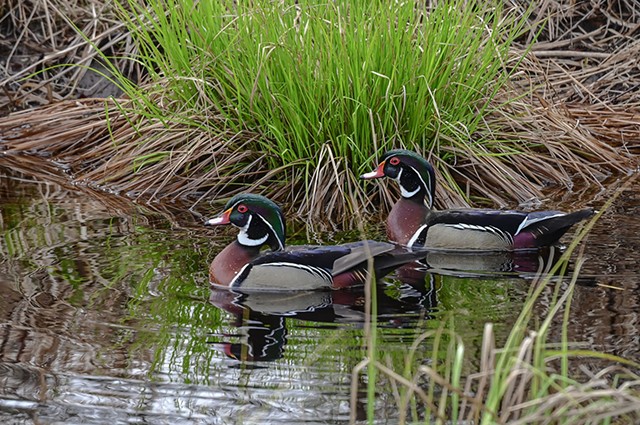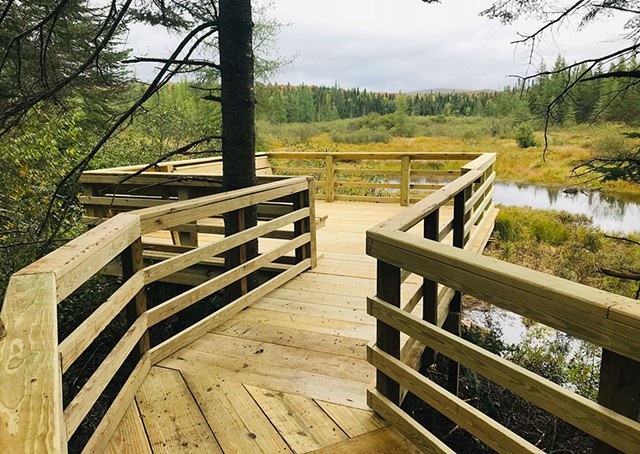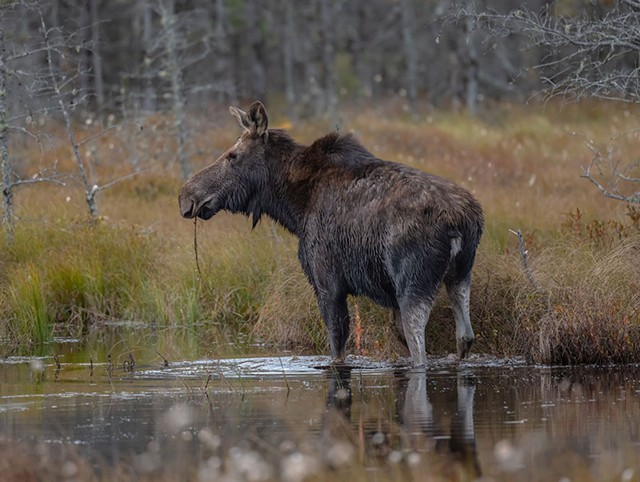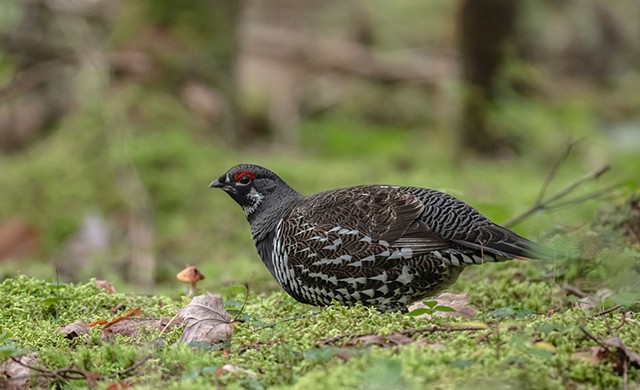
- Courtesy Of Tom Berriman
- Wood ducks
With just 10 people per square mile, Vermont's Essex County is the state's most thinly populated region. Within the area's Silvio O. Conte National Fish and Wildlife Refuge, that peaceful isolation is manifestly clear.
Spring comes late to Vermont's far northeastern corner. Birdsong is still sporadic. But the roar of the Nulhegan River and a chorus of spring peeper frogs more than fill that aural space. Cellphones work little, if at all. A few birds of prey circle silently overhead.
The Silvio O. Conte wildlife refuge, and the quarter-million acres of protected land around it, aren't a regular stop on Vermont's tourist map. The refuge's visitor center in Brunswick is well over a two-hour drive from Burlington, Vermont's largest city, and the area's attractions are low-key. But if you know where to look and you love the outdoors, there's a lot to see and to learn.
"One of the things I like most about it is there aren't very many people out there," said John Predom, an Island Pond resident who is president of the Green Mountain Club's Northeast Kingdom section. Predom, 64 and a photographer, travels the refuge for bird-watching and has taken to studying the bogs and learning about their flora since he retired about five years ago.
"There are some plants there that you can't see anywhere else," he said. A doe and fawn once walked right past him on shore when he was kayaking in Lewis Pond.
Along with many miles of trails and gravel roads, the 26,000-acre Nulhegan Basin portion of the refuge features an array of boardwalks and observation decks, most of them built within the last year or two. Crews of students from the NorthWoods Stewardship Center in nearby Island Pond help construct the boardwalks and trails so that people of many physical abilities can reach the refuge's wetlands.
The popular Mollie Beattie Bog Boardwalk, built in the late 1990s to carry visitors to a black spruce woodland bog, was reconstructed in 2020.

- Courtesy
- Yellow Branch Boardwalk at the Silvio O. Conte refuge
Silvio O. Conte was a Massachusetts member of Congress who worked to preserve the plants, fish, wildlife and habitat in the Connecticut River watershed in Vermont, New Hampshire, Massachusetts and Connecticut. He died in 1991.
The refuge bearing his name stretches across the four states and encompasses the entire watershed. It attracts only 30,000 visitors a year, but from a recreation and research standpoint, it's a busy place.
The 700-mile Northern Forest Canoe Trail, which runs from New York to Maine, travels a stretch of the Nulhegan River in the refuge. A recently constructed 21-mile network of hiking trails extends all the way from Island Pond into the refuge without crossing a single road. And it's one of the few places you can see the state-endangered spruce grouse in Vermont.
Visitors are welcome to walk, bike or snowmobile on the refuge's 40 miles of gravel roads and on its forest trails, and to hunt and fish there in season. Because of the non-native seeds they can carry, horses aren't allowed at Silvio O. Conte or anywhere on the U.S. Fish & Wildlife Service's refuge system nationally, said Steve Agius, the manager of the refuge's Nulhegan Basin division. People who use draft horses to remove moose from the woods in hunting season must get a permit to bring their horses in.
There are 150 million acres protected in wildlife refuges nationwide, Agius said. U.S. Fish & Wildlife considers the Nulhegan River basin valuable because it's the largest remaining section of cold-weather lowland habitat in the state. It is home to rare and endangered species, and the basin is the only known place in Vermont where a breeding Canadian lynx has been spotted, Agius said.
He enjoys knowing the refuge system is protected from development.
"It will forever be the land of the American public, set aside for wildland habitat," he said.

- Courtesy Of Tom Berriman
- Moose in the Silvio O. Conte refuge
The refuge makes up just one parcel of forestland that passed from lumber companies into private hands in the 1990s.
Much of the Essex County land belonged to the Champion International paper company, which sold off 132,000 acres of forest in 1998. The State of Vermont, U.S. Fish & Wildlife Service, and the Seattle-based timber company Weyerhaeuser now own the land, most of which is preserved through a series of agreements with groups such as the Nature Conservancy, the Vermont Housing & Conservation Board, and the Vermont Land Trust. The state calls that conserved forest the Kingdom Heritage Lands.
The land was once home to the Nulhegan Band of the Coosuk Abenaki Nation, whose traditional territories are the upper Connecticut basins of Vermont, northern New Hampshire, and the eastern townships of Québec, according to the University of Vermont's PLACE program, which researches the natural and cultural heritage of Vermont towns.
Before it was extensively harvested for wood and pulp, the land produced huge white pine trees. Other common mountain species were red oak, balsam fir and red spruce. Spruce, maple, hemlock, ash, elm, butternut, cherry and hornbeam grew on the lower slopes and in the valleys.
When the lumber industry was established in the early 19th century, French and English companies extracted logs to build homes and roads and sent the tall pines to Europe for use as ship's masts.
Lumber quickly became the area's dominant industry, and millions of acres were cut in northern New England.

- Courtesy Of Tom Berriman
- State-endangered spruce grouse
In his History of Forestry in Vermont, 1909 to 1959, then-director of Forests, Parks and Recreation Perry H. Merrill wrote that Vermont revolutionary Ira Allen built the first sawmill near Burlington in 1786. By 1840, Vermont's land was fast being cleared for farms, and there were more than 1,000 sawmills in the state. Thousands of feet of lumber were used for building plank roads; logs traveled out of state on the Connecticut River and Champlain Canal and by rail.
By 1870, Burlington was one of the largest lumber processing centers in the United States, importing over 150 million board feet of lumber annually to be sorted and shipped to markets. Just 20 percent of the state was forested; most of Vermont's land then was used for agriculture.
But by the early 1900s, concerned state officials in Vermont were looking for ways to better manage what was left of the state's trees. They commissioned a study of the remaining forest and creating a seedling tree nursery in Burlington. In 1947, Merrill called for forests to be managed not only as moneymaking enterprises but also for watershed protection, recreation and scenic values.
"Forests have been considered as mines of wealth to be exploited at the whims of the owner; as an appendage to the farm to be ruined or saved according to personal desire or needs; or as a product to be removed from the land to make way, in many instances, for a dubious agriculture," he wrote that year. "Our land-holding system tends towards depletion of our soil and timber resources."
The state has been working since then to balance the needs of the wood products industry with recreation, conservation and habitat protection.
Today, forest makes up about 80 percent of Vermont's land surface, and that share is growing, according to the state Department of Forests, Parks and Recreation. There is still plenty of logging under way, but the cutting and replanting are carried out more judiciously.
And scientists are now looking at ways to repair the logging-induced monocultures dominating some areas, including the Silvio O. Conte refuge.

- Courtesy Of Gary Hawley
- Tony D'Amato
Tony D'Amato, a professor who is director of the University of Vermont's forestry program, is leading an experiment at the refuge with several research partners to see if forest managers can restore the diversity that might help the forest adapt to the climate crisis.
Through the project, about 400 acres that were cut and then planted repeatedly with spruce and fir trees for their value as fiber a half-century ago were cleared in patches last summer. Portions of the cleared area are being planted this spring with 14,000 tree seedlings to promote the growth of native plants, trees and animals, some of which haven't been seen in the area for decades.
One goal of the research is to examine whether restoring plant diversity will increase the area's resilience to climate change.
The area was logged so completely for so many years that it's unlikely some of the original tree species can return on their own.
"You can only harvest trees for so many years before there isn't any seed source left," Agius said.
The goal of the project is to restore diversity not only in terms of species but also in terms of tree size and canopy — all qualities that help nurture more of the plants and animals that once called this boreal forest home.
The refuge managers plan to put up signs explaining what's going on, and D'Amato welcomes visitors to email him if they have questions about the project.
"Our goal is to create many adaptive responses that the forest can have to deal with climate change," D'Amato said. "We're restoring the historic complexity."
Agius noted that once-common species such as the bumblebee and the monarch butterfly are being evaluated for inclusion on the federal endangered species list.
"It's a sad state of affairs," he said. "If we don't take action now to protect what we have, then when?"










Comments
Comments are closed.
From 2014-2020, Seven Days allowed readers to comment on all stories posted on our website. While we've appreciated the suggestions and insights, right now Seven Days is prioritizing our core mission — producing high-quality, responsible local journalism — over moderating online debates between readers.
To criticize, correct or praise our reporting, please send us a letter to the editor or send us a tip. We’ll check it out and report the results.
Online comments may return when we have better tech tools for managing them. Thanks for reading.